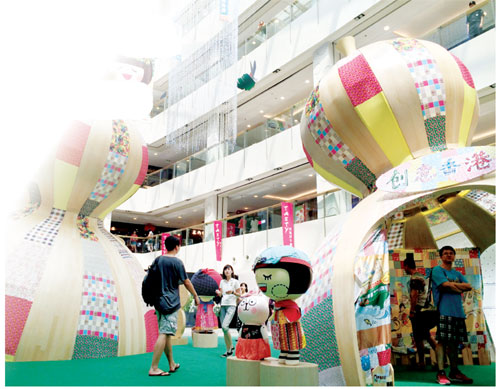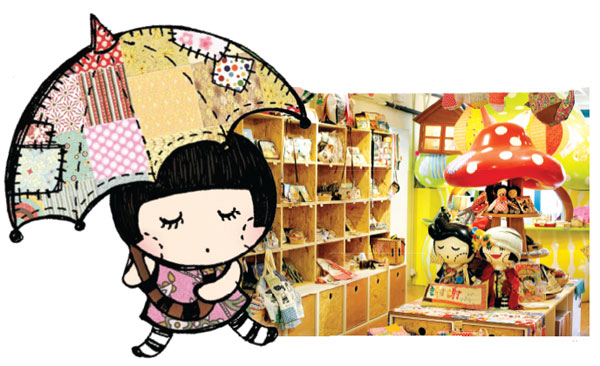An empire built on chocolate dreams
Updated: 2015-08-07 08:29
By Fan Feifei in Beijing(HK Edition)
|
|||||||
In an era when high-tech dominates trend in business, one HK entrepreneur is making her fortune selling handicrafts all based on her childhood dreams.
Prudence Mak Ngar-tuen, founder of the Hong Kong brand "Chocolate Rain", says her handcrafted creations are inspired by her childhood dreams of a wonderland adventure wistfully recalling Hong Kong, the way it was in the 1950s.
It must have been quite some dream. Mak's products are sold in big cities including Tokyo, Paris, New York, London and Madrid. She has flagship stores in Hong Kong and Singapore and a molecular gastronomy theme restaurant - "Fatina and Chefo, Eat and Play" in PMQ, formerly the Police Married Quarters building, in Central, Hong Kong.
Mak founded "Chocolate Rain" in 2000. Each piece she sells, be it toys, clothes, ladies' accessories, or home furniture, is handcrafted, blending the traditional with artistic elements.
"In my childhood, I loved eating chocolate, but didn't like rain because it made us unhappy. Chocolate represents sweetness, while rain represents bitterness. The brand name is just like our life's journey - filled with happiness and misfortune, ups and downs, very tasteful."
A nostalgic creation
The iconic image of Mak's Chocolate Rain creations is a doll named "Fatina", a cute little girl, with short black hair and her eyes closed all day. "She comes from Hong Kong, loves traveling and nature, and is full of smiles."
Mak explains Fatina always closes her eyes to dream, especially on rainy days. Fatina's dreams inspire the imaginations of other girls, guiding them on a kind of quest, to play important roles in defending the environment, while spreading joy and fun. Fatina encourages girls to imagine new ways to make the world better.
"Fatina symbolizes the spirit of Hong Kong in the 1950s or 1960s. I learned about that period from my mother. Fatina's mushroom hairstyle was common among Hong Kong girls' of that era. Her clothes are patchwork. People wore patchwork because they could not afford new clothes," Mak said, adding the handcrafts are carriers of people's feelings evoking nostalgia and love for the past.
At that time, Hong Kong didn't have so many tall buildings. People led more simple lives, caring about and helping one another. "People were poor. They often ate and played together. In contrast, we are rich nowadays, but we communicate less and less, spending more time playing on mobile phones. We shouldn't forget the difficult times."
Mak was born in 1978 in an ordinary family of Hong Kong. Her mother was a tailor, who sewed clothes for her family members and also taught Mak how to sew when she was a kid.
Mak got a degree in Fine Arts at the University of Lethbridge, in Canada in 1998. She was granted the Hong Kong Design Smart scholarship in 2008 and went to Central Saint Martin's London for master's degree in Design. In 2012 she was chosen as one of Hong Kong's Ten Outstanding Young Persons.
"UK has a long history of handcrafted art. People there pursue handcrafts as a hobby and a way of slowing things down. In Hong Kong, handiwork is developing slowly, because people are focused on high tech, finance and the tempo of life in Hong Kong is too fast," Mak said.
Her overseas study brought fresh inspirations to Mak's creations. "I held exhibitions about painting, after my teacher in the UK taught me 'sensory experience', that is, art design should offer an experience for the five senses of your audience. That becomes the most important enlightenment to my creation."
Art design, however, is not always clear sailing. Her handworks were not always popular. Mak said all she could do is to enjoy the happiness brought about by her work.
Mak worked with fashion design students, charity groups and workshops to sew toys. Her mother is also on the team. "She gives me a lot of support," said Mak with a smile.
Promising prospects
To her delight, the creative industries are playing a more important role in Hong Kong's economy, under supportive policies such as the CreateHK initiative.
PMQ, a Hong Kong government effort to support the local creative industry, runs as an art and creative hub much like Beijing's "798". PMQ serves as the base for almost 100 design and creative enterprises.
The biggest difficulty Mak has met is the high rent in Hong Kong. Like some other artists, Mak has moved her workshop to a factory building. "I am considering buying a shop, and hiring more qualified people. Young people don't like handwork because the work is very hard. They just play for fun, but they wouldn't take it as a career," said Mak.
Mak believes Hong Kong is not just for shopping and seeing skyscrapers, but with development in diversified fields. It is the place where East meets West. It's full of opportunity. "If you have a dream or a goal, you can achieve it," said Mak.
Mak isn't neglecting the mainland market. Her exhibition arrived in Beijing last week, as part of the "creative Hong Kong" thematic exhibition, organized by the Hong Kong SAR's Beijing Office.
The exhibition features two gourd-shaped "hulu" houses. Mak explained "hulu" symbolizes wealth and blessings in Chinese culture. People are greeted by pictures of Fatina, and can see her travel around different landmarks of Hong Kong, such as Wetland Park and Hong Kong Science Park. There were also handicraft workshops at the exhibition.
Gracie Foo, director of the HKSAR Beijing Office, said the exhibition aims to create an atmosphere, where visitors can come into direct contact with Hong Kong's creative ambience while enjoying the fun and related activities.
Chen Xiaozhen, a grandma of a 5-year-old girl, visited the exhibition. Chen said her granddaughter loves handicrafts and took time to color Fatina at the workshop. "I haven't been to Hong Kong before, but through the exhibition, I learned more about Hong Kong and I plan to travel there next time," She added.
"Hong Kong is an international city. Artists must have an international vision," Mak said, adding she will hold her exhibition in more mainland cities, and suggested Hong Kong designers jump out of Hong Kong, see more and do crossover with other businesses.
fanfeifei@chinadaily.com.cn
|
Designer Prudence Mak’s gourd-shaped houses featured in the “Creative Hong Kong” thematic exhibition in Beijing from July 30 to Aug 2.Photos Provided To China Daily |

|
Fatina, a little girl with short black hair and her eyes closed all day, is theiconic image of Mak’s “Chocolate Rain” brand. |
(HK Edition 08/07/2015 page10)

